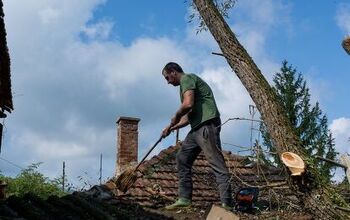Does Homeowner Insurance Cover Mold?

Water damage and mold are two of the most dreaded problems for homeowners, and they go hand in hand. The cost of handling both can be exorbitantly high, and nobody wants to pay for that that without help. So, does homeowner insurance cover mold?
Homeowner insurance covers the cost of mold if the cause of the mold is considered a “covered peril”. For example, your provider will likely cover water damage and mold remediation in sudden events like burst pipes. However, they won’t likely cover mold remediation costs if the water damage and mold are caused by maintenance that you neglected.
It’s important to familiarize yourself with your insurance coverage plan. That way, you can supplement your package with add-ons that provide the most coverage. Follow along as we explore whether homeowner insurance covers mold inspection and remediation costs.
Does Insurance Cover Mold Remediation?
Homeowners insurance typically helps costs associated with mold due to sudden events that are covered. For example, your insurance provider will likely cover the mold remediation in a basement where a pipe froze and burst. Most homeowner insurance providers cover sudden, accidental, unavoidable events.
The insurance company is likely to investigate the situation to see if it could have been avoided. For example, they will likely inspect the scene if mold is present because of a broken water heater. As long as the situation was unavoidable, they should cover the cost of mold remediation and water damage repairs.
Remember that coverage doesn’t always mean they will reimburse the full price. How much of the cost you must pay depends on your plan and the severity of the issue. Check your insurance plan to see a list of the “covered perils” so you can understand your plan better.
When Does Homeowners Insurance Cover Mold?
Homeowners insurance covers mold remediation costs in the case of unpreventable events. For example, most providers cover mold remediation and water damage repairs after a fire. This is often necessary as firefighters must use many gallons of water to extinguish the fire.
The excess moisture eventually creates the perfect conditions for mold to grow and spread. They will also likely cover mold remediation costs if your washing machine or dishwasher fails. Major plumbing issues, such as burst pipes and overflowing toilets, are also typically covered.
Be patient, as it often takes a while for an insurance provider to determine whether you qualify for coverage. Once this happens, they will figure out how much of the costs they will cover. You may have to co-paysome of the cost, but your insurance plan will at least save you a small fortune.
Why Won’t My Insurance Cover Mold Removal?
If your insurance won’t cover mold removal, it’s likely because the cause isn’t included in your list of “covered perils”. That’s especially true if the cause of the mold outbreak is part of a supplemental coverage package you don’t subscribe to. For example, many insurance providers offer flood coverage as a separate package.
Because of that, you may not get coverage if the flood is due to natural causes. This gets confusing, as water damage is covered in most homeowner insurance plans. Water damage coverage refers to damage caused by faulty appliances and plumbing fixtures in most cases.
Flood coverage refers to natural disasters, such as hurricanes and severe cases of rain. It’s worth supplementing your insurance package with flood coverage if you live in an area where flooding is common. That way, you can get at least some reimbursement for natural flood damage and mold remediation. Other scenarios when homeowner insurance won’t cover mold remediation include:
- Unsealed windows
- Poor ventilation
- Neglected leaks
- Broken sump pump
Is Mold Remediation Necessary?
Mold remediation is typically necessary, even if your insurance provider won’t pay for it. Untreated mold can grow and spread, putting you in danger. You may not even be able to see the mold, especially if it’s between walls or under your sinks.
It’s better to remove the mold now before it becomes more widespread and harder to take care of. Otherwise, the cost of mold remediation can increase by hundreds or thousands of dollars. Mold can eventually damage the building materials in your home, and that is dangerous if it gets out of hand.
You may also face respiratory health problems if you stay in a house with lots of mold for too long. Inhaling mold spores can cause lung irritation, difficulty breathing, coughing, and skin irritation. Remediation is essential, as the average person can bounce back from mold exposure once the mold is gone.
Average Mold Inspection Cost
The average cost of a mold inspection is $350, but factors like home size affect the overall cost. Ease of access is another factor that affects mold inspection costs. For example, a simple air test costs as little as $110, whereas checking behind walls is $550 in some cases.
Luckily, insurance companies typically cover the cost of a mold inspection. However, they won’t cover the cost of an inspection if it’s clear that it was caused by something you could have avoided. For example, deferred maintenance that results in water damage is unlikely to be covered.
A mold inspection is necessary if your home has recently suffered water damage. It’s also worth getting a mold inspection if you detect mold throughout your home. The results of the inspection can tell you how severe your situation is and how far the mold has spread.
How Much Does Mold Remediation Cost?
The average cost of mold remediation is $2,289, but it can cost as little as $125-$350 in minor cases. That said, you can expect to spend at least $1,100-$3,500 for mold remediation in severe cases. The severity of the mold outbreak as well as where it’s located affects the overall cost.
Where the mold is located is another big cost factor as that affects how difficult the job is. For example, removing mold from HVAC ductwork costs $500, on average. Removing mold from a crawl space is quite difficult in extreme cases, and it typically costs $450-$4,000.
Basement mold removal costs as little as $500, but it can exceed $2,500 if there is mold behind the walls. Mold prevention treatment is part of the cost as well. It’s typically recommended that you treat the area to prevent further problems, as mold can come back.
How To File A Mold Claim
Acting fast is the first step in filing a mold claim. If it’s because of a flood or water damage, you must turn off the water source right away. Take pictures and or videos of the mold as soon as you notice it to document its progression.
That is an important step, as mold can aggressively grow and spread. Soak up as much water as you can safely reach. It’s also a great idea to run fans or a dehumidifier if possible.
Next, you must call your homeowner insurance provider as soon as possible. Mold remediation is often easier and cheaper if it gets done within 48 hours of discovery. This helps minimize how far the mold spreads. From there, it’s up to your insurance provider to decide how much they will cover if they even cover it at all.
Summing It Up
Insurance providers will pay for the cost of mold inspections and remediation if the cause is covered by your plan. That includes sudden water, and unpreventable water damage. However, they won’t cover mold remediation costs caused by natural disasters unless you have supplemental flood insurance.
Related Guides:

Nick Durante is a professional writer with a primary focus on home improvement. When he is not writing about home improvement or taking on projects around the house, he likes to read and create art. He is always looking towards the newest trends in home improvement.
More by Nick Durante



























